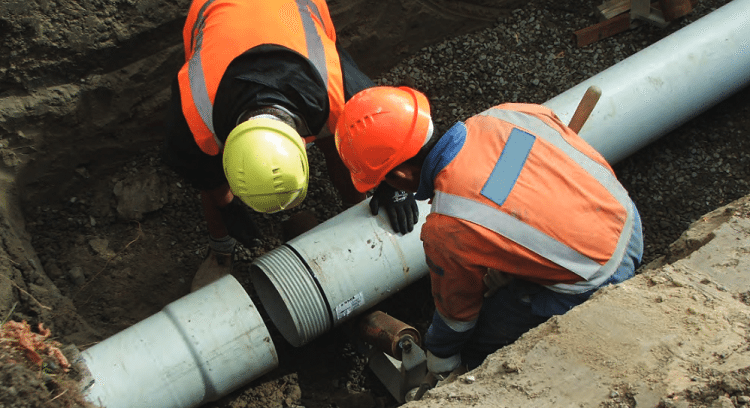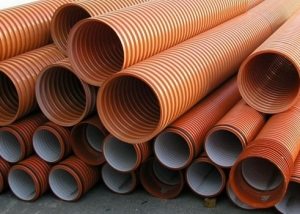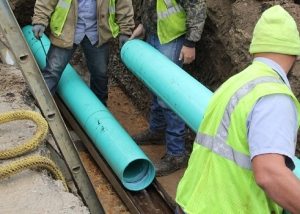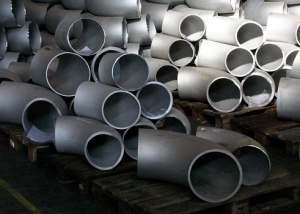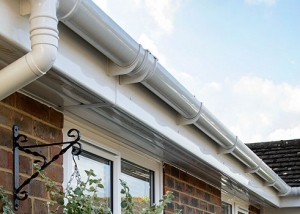Plastic pipes have been considered a natural choice for many years. replacing the old or installing a new sewage system. Modern production is constantly improving the manufacturing technology of plastic construction products. As a result, a wide range of high-quality materials of various shapes and sizes appeared, which caused progress in the construction of reliable, durable sewer pipelines.
Among such materials, it should be noted PVC sewer pipes (polyvinyl chloride) having qualitative advantages.
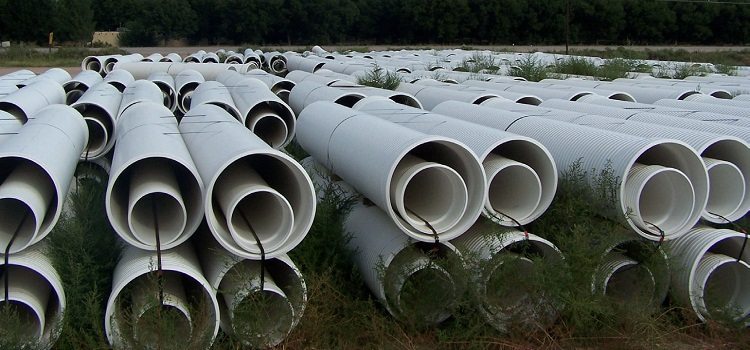
PVC sewer pipes are available in different diameters, so such products can be selected for installation of any network
Content
PVC pipe properties
Polyvinyl chloride pipes have the following qualities:
- ease;
- thermal endurance (-25aboutC ... 70aboutWITH);
- lack of corrosion processes;
- chemical oxidation;
- durability (under normal conditions, the service life is more than 60 years);
- ability after expansion to take its original form;
- minimum thermal conductivity.
The smooth surface inside the plastic pipes does not allow dirt to linger on the walls, prevents siltation, as well as the growth of bacteria, and is resistant to wear from the movement of sewage water with solid particles (sand). This is an important condition for gravity drainage systems where there is no pressure.
Household indoor and outdoor sewer systems can be fully made in PVC material. Installation of such a branch does not cause significant difficulties. Lightweight pipes, varieties of fittings allow you to design any turns and branches, for joining (gluing, soldering) does not require expensive energy-consuming equipment. However, it is worth considering that the sewage system is an engineering structure that is built with strict observance of norms and rules. The proper operation of such a system depends on the correct selection of material and styling features.
Diameters of PVC pipes for indoor and outdoor sewer systems
Material selection for installation of sewer pipeline repelled by his appointment. According to the degree of load, plastic pipes for sewerage are selected with the size necessary for uninterrupted drainage. The decisive selection parameters are diameter and length.
Diameter to be taken into account:
- external, nominal or external (Dн) - the value required for joining parts of the pipeline;
- internal (d) - the most important value that determines the throughput of the outlet, which varies depending on the size of the wall thickness;
- conditional (Du) - the average value of the pipe lumen;
- wall thickness (b) - a value that increases in proportion to the diameter.
Diameters and possible wall thickness of PVC pipes without socket are indicated in the table.
Table 1
| Network type | Dn, mm | d mm | b min, mm | d mm | b max, mm |
| Inner | 32 | 30 | 1,0 | 28,40 | 1,80 |
| 40 | 38 | 1,0 | 36,40 | 1,80 | |
| 50 | 47,4 | 1,30 | 46,40 | 1,80 | |
| 75 | 71,2 | 1,90 | 70,40 | 2,30 | |
| 90 | 85,6 | 2,20 | 84,40 | 2,80 | |
| 110 | 104,6 | 2,70 | 103,20 | 3,40 | |
| Outdoor | 125 | 118,6 | 3,20 | 117,20 | 3,90 |
| 160 | 153,6 | 3,20 | 150,20 | 4,90 | |
| 200 | 192,2 | 3,90 | 187,60 | 6,20 | |
| 250 | 240,2 | 4,90 | 234,60 | 7,70 | |
| 315 | 302,6 | 6,20 | 295,60 | 9,70 | |
| 400 | 384,6 | 7,70 | 375,40 | 12,30 | |
| 500 | 480,4 | 9,80 | 469,40 | 15,30 | |
| 630 | 605,4 | 12,30 | 591,40 | 19,30 | |
| 800 | 769,2 | 15,40 | 751,0 | 24,50 | |
| 1000 | 960,8 | 19,60 | 938,80 | 30,60 | |
| 1200 | 1151 | 24,50 | 1126,80 | 36,60 |
Important! The inner diameter is equal to the outer diameter minus twice the wall thickness. d = Dn-2b
The diameter of PVC sewer pipes (d) for the internal system (intra-house sewer) will be optimal within 32-110 mm, for the external (outlet of internal sewage to the treatment collector) 160-500 mm.
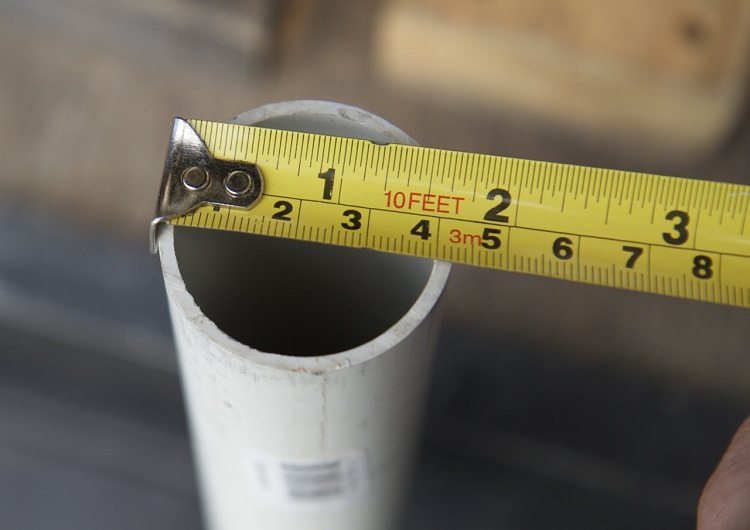
For installation of a drain from plumbing fixtures in a house, pipes with a diameter of up to 50 mm are enough
The sizes of plastic sewer pipes are diverse, there is an explanation for this. All facilities equipped with sewage systems differ in the number and intensity of discharged effluents, and each pipeline branch performs a specific task and carries a certain load.
According to calculations according to building norms and rules (SNiP), standards were determined for the ratio of the diameter and volume of the liquid being washed off in a specified period of time. Therefore, when collecting plastic sewer structures, it is recommended to observe the following parameters:
for internal sewerage:
- internal Ø 25 mm - washing and dishwashing equipment;
- internal Ø 30-47 mm - bidet, sink in the bathroom;
- internal Ø 38-50 mm - bathtub, shower cabin, sink in the kitchen;
- internal Ø 50 mm - joint drain (bath, shower, sink), network wiring inside the house;
- internal Ø 70-86 mm - riser bends;
- internal Ø 100-118 mm - toilet bowl, central riser;
for external sewage:
- internal Ø 150-190 mm - discharge of effluents to treatment systems;
- internal Ø 200 mm - including bath / sauna;
- internal Ø 240-300 mm - including the pool;
- internal Ø 300-1100 mm - city sewer highways.
Important! The diameter of the horizontally laid outlet must be equivalent (but not more) to the diameter of the riser in order to avoid clogging.
This is important to consider when attaching the toilet, which is closest to the riser. In this case, the pattern works that the permeability of the drain will be equal to the permeability of the smallest pipe circumference. Regarding the bath, there is no point in increasing the tap.
The choice of the widest diameter for flushing the toilet is also due to the fact that a large number of drains of a heterogeneous composition, passing at a speed, should not fill the entire space of the pipe, preventing the free movement of air. Vacuum formation in plastic taps will cause system malfunctions. The presence of a gap ensures the displacement of pressurized air masses.
Calculation of the construction of sewer risers taking into account the diameter and length
Materials and plumbing equipment on the basis of which plastic sewer systems are constructed, mostly standard with an already calculated allowable indicator of water flow. Therefore, the preparation of building a plastic riser comes down to a comparison of diameters, docking angle, length and throughput.
The length of sewer pipes varies from 1m to 6m. This parameter also affects the rate of wastewater discharge. So PVC pipes for sewerage in the sizes of 1 m and 5 m, diameter 110 mm, installed by the working riser, have a throughput of 10.6 and 3 l / s, respectively. The flowing speed of the risers, the length of which increases, decreases, due to overcoming inhomogeneous fluids against the walls with the resistance of air masses.
Table No. 2 summarizes the throughput indicators of the plastic components with a ratio of riser diameters, taps and docking angles according to SNiP.
table 2
| Inside diameter of branches, mm | Deviation at the connection of the branch and riser, deg | Throughput ability, l / s
risers with outer diameter, mm |
|
| 50 | 110 | ||
| 36,4 | 45 | 1,24 | 8,96 |
| 60 | 1,15 | 8,26 | |
| 90 | 0,77 | 5,55 | |
| 46,4 | 45 | 1,08 | 8,41 |
| 60 | 1,01 | 7,81 | |
| 90 | 0,67 | 5,21 | |
| 104,6 | 45 | — | 5,91 |
| 60 | — | 5,41 | |
| 90 | — | 3,61 | |
The dependence of the throughput of the pipeline on the length of the riser is presented in table No. 3.
Table 3
| Riser length, m | Deviation at the connection of the branch and riser, deg | Throughput ability, l / s
risers with outer diameter, mm and outer diameter of bends, mm |
||||
| 50 | 110 | |||||
| 40 | 50 | 40 | 50 | 110 | ||
| 1,0 | 45 | 1,61 | 1,81 | 8,81 | 9,51 | 10,61 |
| 60 | 1,54 | 1,71 | 8,51 | 9,11 | 10,11 | |
| 90 | 1,46 | 1,66 | 8,10 | 8,41 | 9,51 | |
| 2,0 | 45 | 0,97 | 1,13 | 5,41 | 5,81 | 6,81 |
| 60 | 0,92 | 1,06 | 5,11 | 5,51 | 6,41 | |
| 90 | 0,90 | 0,99 | 4,71 | 4,96 | 5,91 | |
| 3,0 | 45 | 0,73 | 0,81 | 3,81 | 4,01 | 5,01 |
| 60 | 0,68 | 0,75 | 3,51 | 3,71 | 4,61 | |
| 90 | 0,59 | 0,66 | 3,21 | 3,31 | 4,11 | |
| 4,0 | 45 | 0,53 | 0,61 | 2,81 | 3,01 | 3,71 |
| 60 | 0,49 | 0,57 | 2,61 | 2,71 | 3,41 | |
| 90 | 0,43 | 0,49 | 2,31 | 2,41 | 3,01 | |
| 5,0 | 45 | 0,52 | 0,61 | 2,11 | 2,26 | 3,01 |
| 60 | 0,48 | 0,56 | 1,96 | 2,06 | 2,71 | |
| 90 | 0,43 | 0,49 | 1,78 | 1,86 | 2,41 | |
| 6,0 | 45 | 0,52 | 0,62 | 1,78 | 1,86 | 2,36 |
| 60 | 0,49 | 0,56 | 1,68 | 1,71 | 2,11 | |
| 90 | 0,43 | 0,49 | 1,43 | 1,52 | 1,81 | |
The table shows that the larger the docking angle deviates from 0 deg., The less the ability of the riser to drain drains.Even if you increase the diameter, the throughput of the pipe will be lower compared to the analog of a smaller diameter installed to the riser at a small angle.
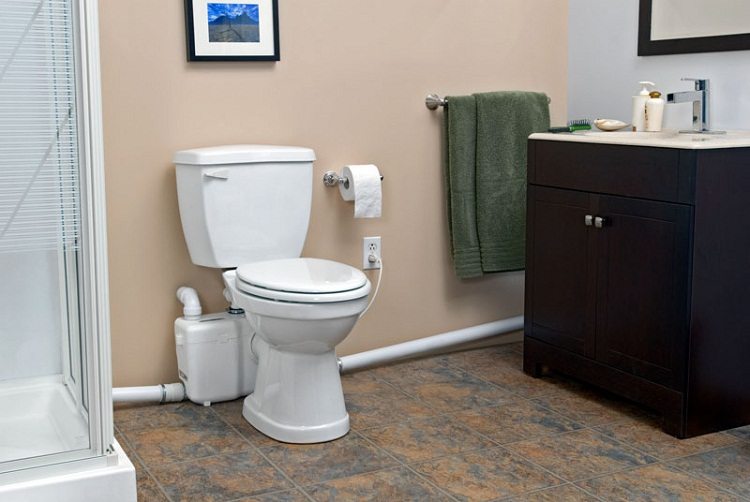
Regardless of the diameter of the pipes, they must be laid in accordance with a strictly calculated slope.
During the calculation of the construction of the sewage system, right angles should be avoided when connecting the taps, this creates unfavorable conditions in the operation of the sewer. Steep trajectories greatly reduce the speed of water movement, there is a risk of clogging, the pipe does not have time to clean itself. In places of the pipeline with a minimum speed, an increase in diameter is necessary.
For self-cleaning of pressureless sewer systems during the laying of the network, it is necessary to observe a slope, since drains flow under the action of gravity. The determination of the level of inclination is affected by the size of the plastic bends. The optimal slope is considered:
- 3 cm per 1 m pipe dia. up to 50 mm;
- 2 cm per 1 m pipe dia. up to 100 mm;
- 1 cm per 1 m pipe dia. up to 200 mm.
When creating a slope, it should be borne in mind that the drains contain inclusions of varying hardness, fat that hardens when the temperature of the liquid decreases (average temperature of sewage water 40aboutC), therefore, a small slope will lead to traffic jams, and a large one will lead to a rapid runoff of water and sedimentation of solid waste.
Pressure sewer networks are equipped with a pumping station with a cutting mechanism for grinding solid waste. It provides complete drainage without any blockages. In this case, it is possible not to observe the slope, using unplasticized PVC pipes of smaller diameter.
The length of the pipes connected to the riser should not be more than 1.5 m for the toilet and 3.5 m of other plumbing fixtures. Lengthening requires laying plastic bends of a larger diameter with the use of an aeration valve, otherwise, when flushing, there will be a vacuum, water from the devices adjacent to the riser will be sucked out, all this is accompanied by a disgusting smell, sound, breakage.
Imported plastic sewer products often have the size indicated in inches. The main thing here is not to make a mistake and install it correctly. It’s easier to choose the right diameter, translating it into millimeters (1 inch = 25.40 mm). Fractional values are often found, so 1⅜ ″ = 32.0 mm; 2 ⅛ ″ = 54.0 mm.
Whatever design decisions are embodied, there are rules for the installation of sewers that must be followed. A good solution when choosing a material with its further installation is to contact a specialist. An independent option always begins with a study of the issue and careful calculations.
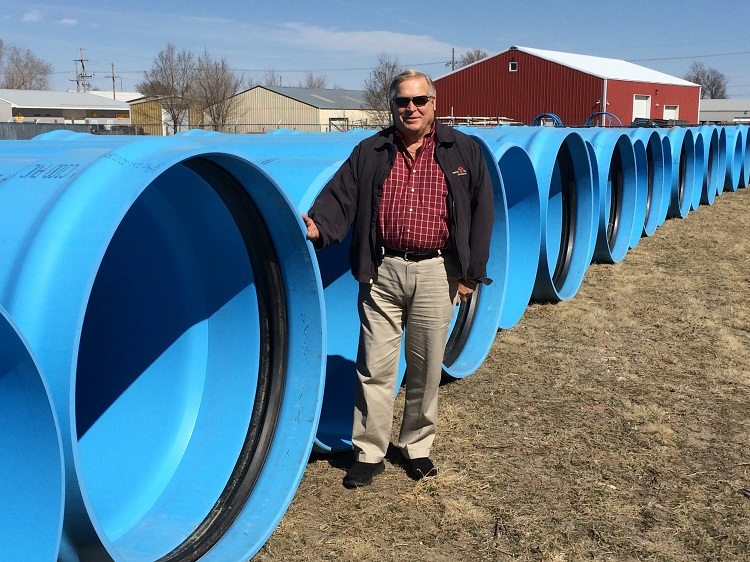
The pipes of the largest diameters are used for the installation of urban sewer systems, where drains in very large volumes are reduced
Sewer plastic pipes for external use
Unlike internal, external PVC sewer pipes take on much more impressive dimensions. The impact factors on such pipes are completely different: it is a temperature drop, ground pressure, heavy loads, and a chemically aggressive environment. Materials for the street highway are made from unplasticized polyvinyl chloride, resistant to oils, solvents and acids. Such plastic sewer systems meet all technical requirements, so they can provide a fifty-year service life.
The dimensions of the external sewage system are not clearly standardized; there are recommendations regarding the diameter of the pipeline, which should be equal to the external trunk indicator.
The diametrical dimensions of sewer pipes can reach up to 1.2 m with a wall thickness of 37 mm. They are laid deep into the ground at 2 - 8 m, based on the stiffness class of the material. The ability of the network to withstand pressures up to 16 bar allowed the plastic pipeline to replace the cast iron one.
The dimensions of the popular PVC sewer pipes for outdoor installation are presented in table No. 4.
Table 4
| Dn, mm | b mm | Length m | Dn, mm | b mm | Length m | |
| 110 | 3,21 | 0,56 | 250 | 6,21 | 1,2 | |
| 1 | 2 | |||||
| 2 | 3 | |||||
| 3 | 4 | |||||
| 4 | 6,13 | |||||
| 6,06 | 315 | 7,71 | 1,2 | |||
| 160 | 4,0 | 1 | 2 | |||
| 1,2 | 3 | |||||
| 2 | 6,14 | |||||
| 3 | 400 | 9,81 | 1,2 | |||
| 4 | 2 | |||||
| 6,08 | 3 | |||||
| 200 | 4,91 | 1,2 | 6,15 | |||
| 2 | 500 | 12,31 | 3 | |||
| 3 | 6,16 | |||||
| 4 | 600 | 19,31 | 3 | |||
| 6,09 | 6,17 |
Most importantly, in PVC sewer pipes, the dimensions remain unchanged over time. Low thermal conductivity and a smooth surface do not allow draining to solidify, silting up the pipeline. The right choice of assembly method, as well as diameter from a wide range of sizes of plastic components, will ensure reliable operation of PVC sewers with excellent characteristics.
